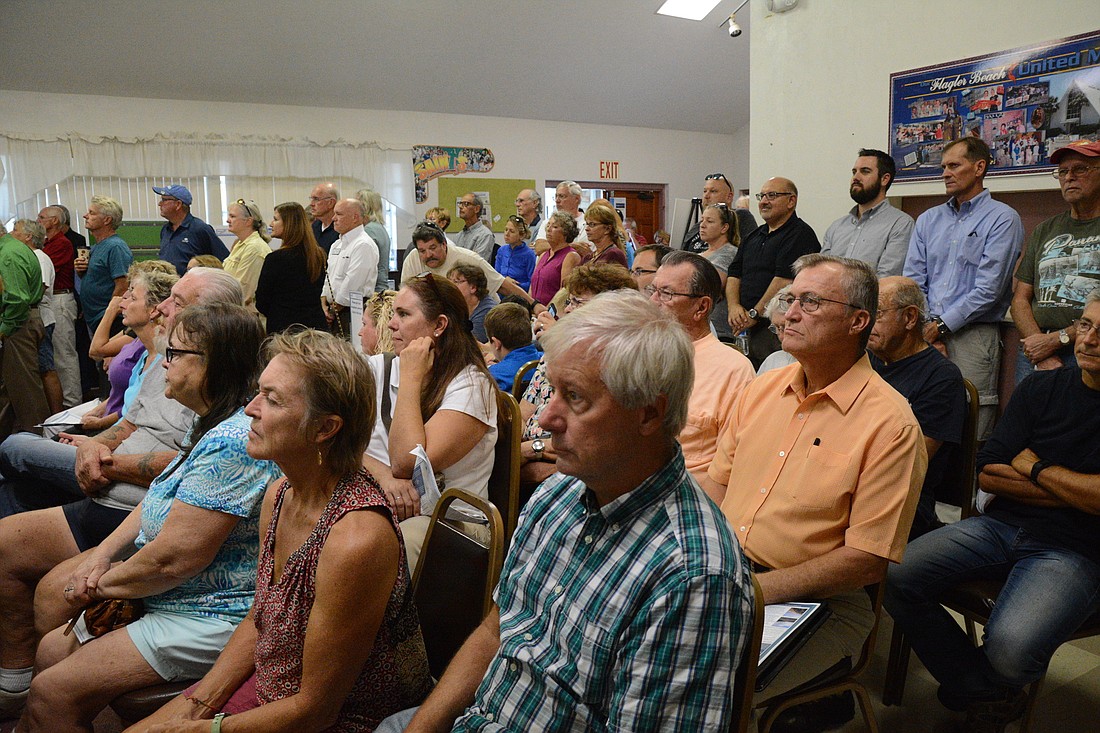- December 13, 2025

The changes the Florida Department of Transportation wants to make to repair a stretch of State Road A1A damaged by Hurricane Matthew — building one lane each way from South 22 Street to South Ninth Street, separated by a vegetated median — drew little ire from a crowd of about 160 people at a public meeting Nov. 2.
But it didn't satisfy attendees either, and one thing united most of the complaints of the 14 people who took the mic to comment: They felt the proposal wouldn't do enough to protect the road in the future.
The Flagler Beach Methodist Church on South Daytona Avenue was filled to overflowing for the hearing the evening of Nov. 2, with locals taking every seat and standing shoulder to shoulder along the church's walls. The Florida Department of Transportation had convened the meeting to accept comments from members of the public on plans for A1A in Flagler Beach, something it has done in the past. The Nov. 2 meeting was the first held after Hurricane Irma.
FDOT staff opened the meeting with an open house so residents could ask questions and look at plans, and FDOT showed a 13-minute presentation about its proposal, viewable here.
The project would start in the summer of 2018, take about a year and cost about $4.9 million, and closures would proceed about a block at a time, with southbound traffic detouring onto Central Avenue and northbound traffic remaining on A1A. There would be no parking on the beachside, speed limits in the project area would be 30 mph, and lanes would be 10 feet wide with a 10-foot wide median that would include a French drain system. There would be a six-foot sidewalk on the inland side and accesses for businesses and homes.
The rock revetment that's in place now would stay, but there would be no further structural reinforcement and no seawall in the area.
Residents called that insufficient.
"There is just relentless erosion on the beach," said Ted Barnhill, a Lambert Avenue resident who also owns property that fronts A1A. "We have been very fortunate we've not had a major hurricane directly hit the city. Either Matthew or Irma could have been catastrophic —could have taken out the entire A1A and a number of properties to the west of it. This particular project has problems, and it doesn't protect the road. ... Loose rock and sand will not protect the road. ... I believe that the city needs to take a position that we want a buried seawall. ... Otherwise, we lose A1A; we force the traffic down through the middle of Flagler Beach or somewhere else."
Two other speakers said they agreed with him. But seawalls have been controversial in Flagler Beach because of concerns that they speed erosion.
The Army Corps of Engineers, which has long planned a project to replenish the city's beaches by adding sand to widen the dune and replenishing it periodically, has also indicated that it does not want to undertake that plan in seawall areas — something one resident pointed out in a comment suggesting the city approach the Army Corps to get the renourishment project started rather than pushing for a seawall that might kill the renourishment project.
Flagler Beach City Commissioner Joy McGrew said she does not support seawalls.
"I just don't want to see a wall," she said at the meeting. Residents applauded. "If somebody could prove to me that you can put a wall in, bury it, and then affix some system of stabilization of the rock system that you put in front of that wall ... so it's not sucked out every time we get a nor'easter, then I would believe in something like a wall."
Of the possible plans for A1A, she said, the one FDOT was presenting drew the most support from city commissioners.
"Is it perfect? No. Is it going to be painful? Yes," she said. "So, put on your seatbelts. If you want a road, it's gonna hurt to live on Central and Daytona and Flagler and put up with the traffic. If DOT and some of the other agencies — the county, Highway Patrol — do what they should do, which is help us, then we can put out on the streets enough enforcement to try to keep the speeds down."
Other speakers asked about dune walkovers and beach access, and McGrew said that those are coming — they're under the city's jurisdiction, not FDOT's.
FDOT spokesman Steve Olsen acknowledged that the road would remain vulnerable to a direct strike from a major hurricane.
"If you take a direct strike, there's not a guarantee that there will be no damage," he said. "We're doing the best we can to try to mitigate it."